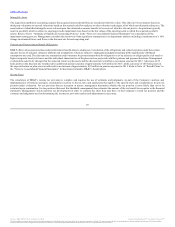BB&T 2014 Annual Report Download - page 80
Download and view the complete annual report
Please find page 80 of the 2014 BB&T annual report below. You can navigate through the pages in the report by either clicking on the pages listed below, or by using the keyword search tool below to find specific information within the annual report.
Table of Contents
Tier 1 Capital Ratio 10.0 % 7.5 %
Total Capital Ratio 12.0 9.5
Tier 1 Leverage Capital Ratio 7.0 5.0
Tangible Common Equity Ratio 6.0 4.0
Tier 1 Common Equity Ratio 8.5 6.0
Payments of cash dividends and repurchases of common shares are the methods used to manage any excess capital generated. In addition, management
closely monitors the Parent Company’s double leverage ratio (investments in subsidiaries as a percentage of shareholders’ equity). The active management of
the subsidiaries’ equity capital, as described above, is the process used to manage this important driver of Parent Company liquidity and is a key element in
the management of BB&T’s capital position.
Management intends to maintain capital at Branch Bank at levels that will result in classification as “well-capitalized” for regulatory purposes. Secondarily,
it is management’s intent to maintain Branch Bank’s capital at levels that result in regulatory risk-based capital ratios that are generally comparable with
peers of similar size, complexity and risk profile. If the capital levels of Branch Bank increase above these guidelines, excess capital may be transferred to the
Parent Company in the form of special dividend payments, subject to regulatory and other operating considerations.
While nonrecurring events or management decisions may result in the Company temporarily falling below its operating minimum guidelines for one or more
of these ratios, it is management’s intent through capital planning to return to these targeted operating minimums within a reasonable period of time. Such
temporary decreases below the operating minimums shown above are not considered an infringement of BB&T’s overall capital policy, provided a return
above the minimums is forecast to occur within a reasonable time period.
BB&T regularly performs stress testing on its capital levels and is required to periodically submit the company’s capital plans to the banking regulators.
During March 2014, BB&T announced that the FRB did not object to the Company’s 2014 capital plan. The 2015 capital plan was submitted during January
2015. Management’s capital deployment plan in order of preference is to focus on organic growth, dividends, strategic opportunities and share repurchases.
Risk-based capital ratios, which include Tier 1 Capital, Total Capital and Tier 1 Common Equity, are calculated based on regulatory guidance related to the
measurement of capital and risk-weighted assets.
BB&T’s Tier 1 common equity ratio was 10.6% at December 31, 2014 compared to 9.9% at December 31, 2013. The increase in regulatory capital was
primarily due to strong capital generation during 2014.
79
Source: BB&T CORP, 10-K, February 25, 2015 Powered by Morningstar® Document Research℠
The information contained herein may not be copied, adapted or distributed and is not warranted to be accurate, complete or timely. The user assumes all risks for any damages or losses arising from any use of this information,
except to the extent such damages or losses cannot be limited or excluded by applicable law. Past financial performance is no guarantee of future results.
























